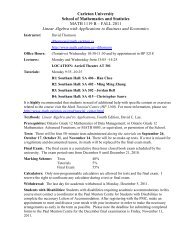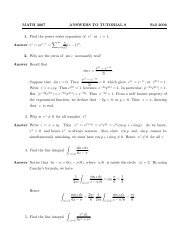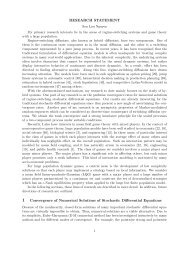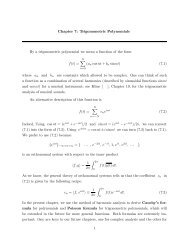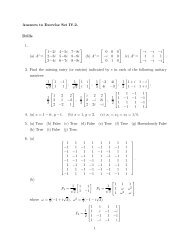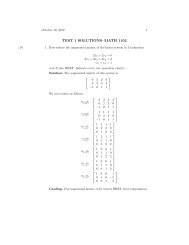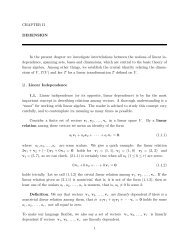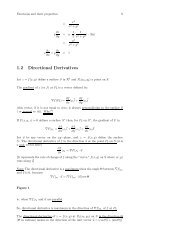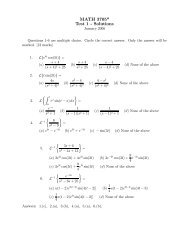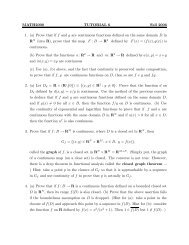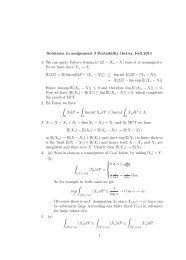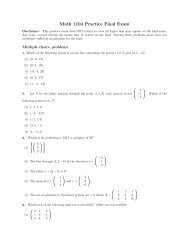SOLUTIONS TO TEST 2–MATH 1102
SOLUTIONS TO TEST 2–MATH 1102
SOLUTIONS TO TEST 2–MATH 1102
You also want an ePaper? Increase the reach of your titles
YUMPU automatically turns print PDFs into web optimized ePapers that Google loves.
2<br />
November 5, 2012 1<br />
<strong>SOLUTIONS</strong> <strong>TO</strong> <strong>TEST</strong> <strong>2–MATH</strong> <strong>1102</strong><br />
1. Suppose the matrix<br />
⎡<br />
⎢<br />
⎣<br />
1 4 0 0 2 1 0<br />
0 0 1 0 1 −3 0<br />
0 0 0 1 2 −6 0<br />
0 0 0 0 0 0 0<br />
is the RREF of the augmented matrix of a system of linear equations<br />
over C.<br />
(a) Compute the solution set to this system in vector form.<br />
Solution: The indicies of the columns without leading ones and<br />
corresponding to free variables are 2, 5 and 6. (The final column<br />
corresponds to the vector of constants, not a variable.) We must<br />
solve for the dependent variables x1, x3 and x4:<br />
The solution set is<br />
⎧⎡<br />
⎪⎨<br />
⎢<br />
⎣<br />
⎪⎩<br />
⎧<br />
⎪⎨<br />
⎢<br />
= c2 ⎢<br />
⎣<br />
⎪⎩<br />
x4 = −2x5 + 6x6<br />
⎤<br />
⎥<br />
⎦<br />
x3 = −x5 + 3x6<br />
x1 = −4x2 − 2x5 − x6.<br />
−4c2 − 2c5 − c6<br />
c2<br />
−c5 + 3c6<br />
−2c5 + 6c6<br />
c5<br />
c6<br />
⎡<br />
−4<br />
1<br />
0<br />
0<br />
0<br />
0<br />
⎤<br />
⎡<br />
⎥ ⎢<br />
⎥ ⎢<br />
⎥ ⎢<br />
⎥ + c5 ⎢<br />
⎥ ⎢<br />
⎦ ⎣<br />
⎤<br />
⎫<br />
⎥<br />
⎪⎬<br />
⎥ : c2, c5, c6 ∈ C<br />
⎥<br />
⎦<br />
⎪⎭<br />
−2<br />
0<br />
−1<br />
−2<br />
1<br />
0<br />
⎤<br />
⎡<br />
⎥ ⎢<br />
⎥ ⎢<br />
⎥ ⎢<br />
⎥ + c6 ⎢<br />
⎥ ⎢<br />
⎦ ⎣<br />
−1<br />
0<br />
3<br />
6<br />
0<br />
1<br />
⎤<br />
⎫<br />
⎥<br />
⎪⎬<br />
⎥ : c2, c5, c6 ∈ C .<br />
⎥<br />
⎦<br />
⎪⎭<br />
Grading: 2 for identifying free/dependent variables. 2 for solution<br />
set. 2 for vector form.<br />
(b) Write the solution set above as the span of some vectors.<br />
Solution:<br />
⎧⎡<br />
⎪⎨<br />
⎢<br />
span ⎢<br />
⎣<br />
⎪⎩<br />
−4<br />
1<br />
0<br />
0<br />
0<br />
0<br />
⎤<br />
⎡<br />
⎥ ⎢<br />
⎥ ⎢<br />
⎥ ⎢<br />
⎥ , ⎢<br />
⎥ ⎢<br />
⎦ ⎣<br />
−2<br />
0<br />
−1<br />
−2<br />
1<br />
0<br />
⎤<br />
⎡<br />
⎥ ⎢<br />
⎥ ⎢<br />
⎥ ⎢<br />
⎥ , ⎢<br />
⎥ ⎢<br />
⎦ ⎣<br />
−1<br />
0<br />
3<br />
6<br />
0<br />
1<br />
⎤⎫<br />
⎥<br />
⎥⎪⎬<br />
⎥<br />
⎦<br />
⎪⎭
8<br />
November 5, 2012 2<br />
2. Determine a linearly independent subset of<br />
⎧⎡<br />
⎤ ⎡ ⎤ ⎡ ⎤ ⎡ ⎤ ⎡<br />
⎨ 1 −1 −3 1<br />
S = ⎣ 0 ⎦ , ⎣ 1 ⎦ , ⎣ 1 ⎦ , ⎣ 0 ⎦ , ⎣<br />
⎩<br />
0 0 0 2<br />
whose span is equal to spanS.<br />
−1<br />
−2<br />
−8<br />
⎤⎫<br />
⎬<br />
⎦ ⊆ R3<br />
⎭<br />
Solution: Following Theorem BS, we write the matrix whose columns<br />
are given by the above vectors in the order that they appear<br />
⎡<br />
1 −1 −3 1<br />
⎤<br />
−1<br />
⎣ 0 1 1 0 −2 ⎦ .<br />
0 0 0 2 −8<br />
Row-reducing, we obtain<br />
R1+R2<br />
→<br />
(1/2)R3<br />
→<br />
R1−R3<br />
→<br />
⎡<br />
⎣<br />
⎡<br />
⎣<br />
⎡<br />
⎣<br />
1 0 −2 1 −3<br />
0 1 1 0 −2<br />
0 0 0 2 −8<br />
1 0 −2 1 −3<br />
0 1 1 0 −2<br />
0 0 0 1 −4<br />
1 0 −2 0 1<br />
0 1 1 0 −2<br />
0 0 0 1 −4<br />
The indices of the columns with leading ones are 1, 2 and 4. Therefore<br />
⎧⎡<br />
⎤ ⎡ ⎤ ⎡ ⎤⎫<br />
⎨ 1 −1 1 ⎬<br />
⎣ 0 ⎦ , ⎣ 1 ⎦ , ⎣ 0 ⎦<br />
⎩<br />
⎭<br />
0 0 2<br />
is a linearly independent subset of the above set with the same span.<br />
Grading: 2 for matrix. 3 for RREF. 3 for identifying linearly independent<br />
subset.<br />
3. The set of vectors<br />
⎧⎡<br />
⎨<br />
⎣<br />
⎩<br />
1<br />
0<br />
0<br />
⎤<br />
⎡<br />
⎦ , ⎣<br />
1<br />
i<br />
0<br />
⎤<br />
⎡<br />
⎦ , ⎣<br />
i<br />
1<br />
0<br />
⎤<br />
⎦<br />
⎤<br />
⎦<br />
⎤<br />
⎦ .<br />
⎤⎫<br />
⎬<br />
⎦ ⊆ C3<br />
⎭
6<br />
/3<br />
/4<br />
/1<br />
/3<br />
November 5, 2012 3<br />
is linearly dependent. Compute and display a non-trivial linear dependence<br />
relation by first solving the appropriate homogeneous system of<br />
linear equations.<br />
Solution: Any linear dependence relation is a solution to the homogeneous<br />
system of linear equations whose augmented matrix is<br />
⎡<br />
1<br />
⎣ 0<br />
1<br />
i<br />
i<br />
1<br />
⎤<br />
0<br />
0 ⎦<br />
0 0 0 0<br />
−iR2<br />
⎡<br />
1<br />
−→ ⎣ 0<br />
1<br />
1<br />
i<br />
−i<br />
⎤<br />
0<br />
0 ⎦<br />
0 0 0 0<br />
R1−R2<br />
⎡<br />
1<br />
−→ ⎣ 0<br />
0<br />
1<br />
2i<br />
−i<br />
⎤<br />
0<br />
0 ⎦ .<br />
0 0 0 0<br />
The RREF on the right allows us to read off the solution x3 = 1,<br />
x2 = i and x1 = −2i. The corresponding non-trivial linear dependence<br />
relation is<br />
⎡<br />
−2i ⎣<br />
1<br />
0<br />
0<br />
⎤<br />
⎡<br />
⎦ + i ⎣<br />
1<br />
i<br />
0<br />
⎤<br />
⎡<br />
⎦ + 1 ⎣<br />
i<br />
1<br />
0<br />
⎤<br />
⎡<br />
⎦ = ⎣<br />
Grading: 2 for augmented matrix. 2 for non-trivial solution. 2 for<br />
non-trivial dependence relation.<br />
4. Suppose F is a field and v, w ∈ F n . Define the vector v + w.<br />
Solution: [v + w]j = [v]j + [w]j for all 1 ≤ j ≤ n.<br />
5. Suppose F is a field and w, v ∈ F n . Prove that v + w = w + v.<br />
Solution: Suppose 1 ≤ j ≤ n. Then, by the commutativity of addition<br />
in F<br />
[v + w]j = [v]j + [w]j = [w]j + [v]j = [w + v]j.<br />
Therefore v + w = w + v.<br />
Grading: 2 for expressing the entries of v + w. 2 for using commutativity<br />
in F .<br />
6. What is the property in the previous exercise called?<br />
Solution: The commutativity of vector addition.<br />
7. Suppose F is a field. Define the identity matrix In ∈ Mnn(F ).<br />
Solution: For 1 ≤ j, k ≤ n<br />
[In]jk =<br />
1 if j = k<br />
0 if j = k .<br />
0<br />
0<br />
0<br />
⎤<br />
⎦ .
6<br />
/6<br />
November 5, 2012 4<br />
8. Suppose F is a field and w, v1, . . . , vk ∈ F n .<br />
(a) Prove that<br />
span{v1, . . . , vk} ⊆ span{w, v1, . . . , vk}.<br />
Solution: Suppose α1v1 + · · · + αkvk ∈ span{v1, . . . , vk} for some<br />
α1, . . . , αk ∈ F . Then<br />
α1v1 + · · · + αkvk = 0w + α1v1 + · · · + αkvk ∈ span{w, v1, . . . , vk}.<br />
Grading: 2 for style of proof. 2 for correct linear combination. 2<br />
for equation.<br />
(b) Suppose further that w ∈ span{v1, . . . vk}. Prove that<br />
span{v1, . . . , vk} = span{w, v1, . . . , vk}.<br />
Solution: In view of 8 (a), it suffices to prove the containment<br />
span{v1, . . . , vk} ⊇ span{w, v1, . . . , vk}.<br />
Suppose αw+α1v1+· · ·+αkvk ∈ span{w, v1, . . . , vk} for some α, α1, . . . , αk ∈<br />
F . Since w ∈ span{v1, . . . vk} there exists β1, . . . βk ∈ F such that<br />
w = β1v1 + · · · + βkvk. Substituting this linear combination in for w<br />
above we obtain<br />
αw + α1v1 + · · · + αkvk = α(β1v1 + · · · + βkvk) + α1v1 + · · · + αkvk<br />
= (αβ1 + α1)v1 + · · · + (αβk + α1)vk<br />
and this last linear combination belongs to span{v1, . . . , vk}. This<br />
proves the desired containment.<br />
Grading: 2 correct containment. 2 for substituting linear combination<br />
in for w. 2 for showing the substitution lies in span{v1, . . . , vk}.
3<br />
/3<br />
November 5, 2012 5<br />
9. Indicate whether each of the two statements below is true or false. If<br />
you think a statement is true, provide some justification. If you think<br />
a statement is false, provide a counterexample to it.<br />
(a) Suppose F is a field, {v1, . . . , vk} ⊂ F n is linearly independent,<br />
and 1 ≤ j ≤ k. Then {v1, . . . , vj} is linearly independent.<br />
Solution: True. Suppose α1, . . . αj ∈ F such that<br />
Then<br />
α1v1 + · · · + αjvj = 0.<br />
α1v1 + · · · + αjvj + 0vj+1 + · · · + 0vk = 0.<br />
The linear independence of {v1, . . . , vk} now implies that α1 =<br />
· · · = αk = 0. In conclusion, we have proven that<br />
α1v1 + · · · + αjvj = 0 ⇒ α1 = · · · = αk = 0.<br />
(b) Suppose F is a field. Every square matrix with entries in F is<br />
non-singular.<br />
Solution: False. The matrix<br />
<br />
0 0<br />
A = ∈ M22(F )<br />
0 0<br />
is square but the solution set to LS(A, 0) is F 2 . In particular,<br />
there are non-trivial (non-zero) solutions. Therefore A is (very)<br />
singular.



